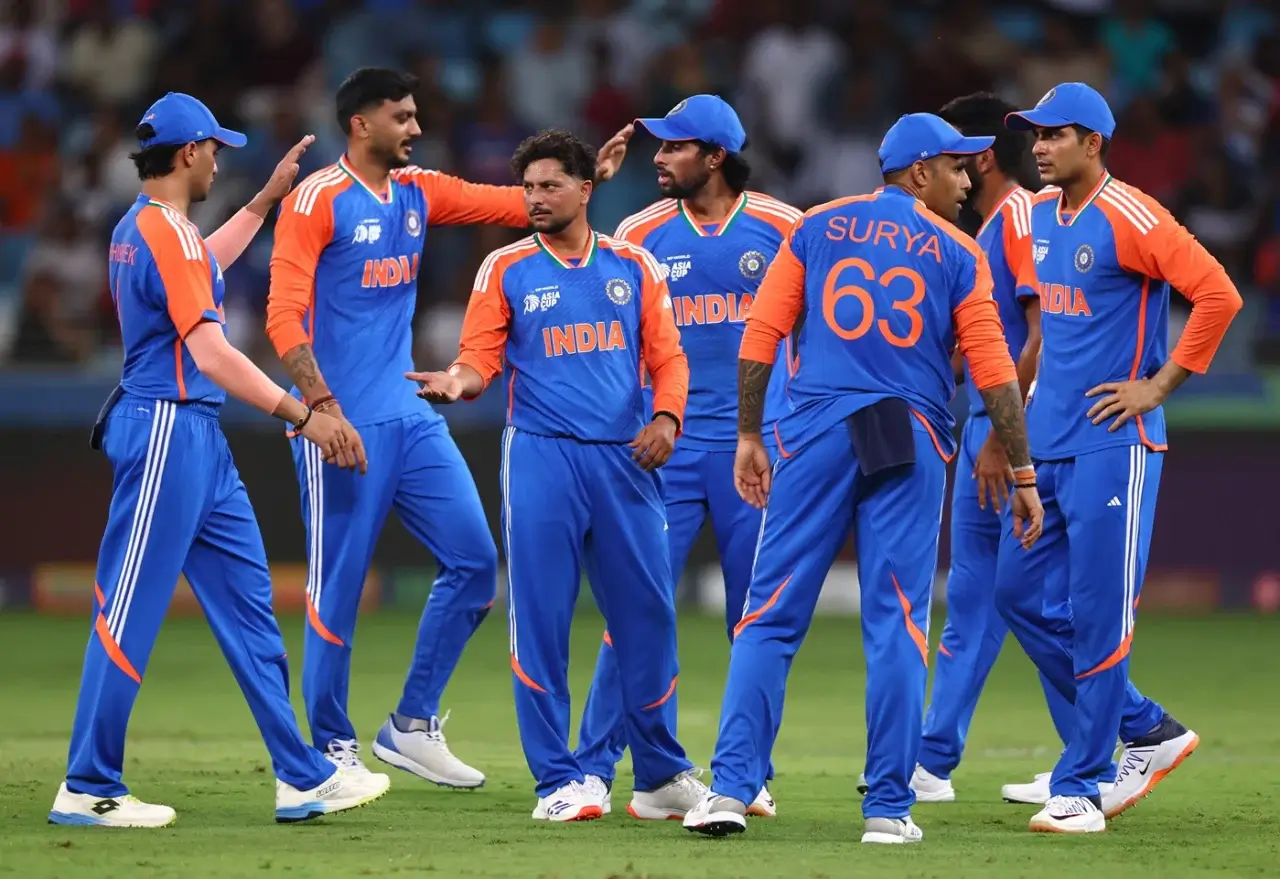Pakistan’s Asia Cup 2025 opener against Oman in Dubai produced a game of two halves. Pakistan, after electing to bat first, managed 160 for 7 on a slow and tricky surface. Mohammad Haris was the standout performer, scoring 66 from 43 balls and changing the flow of the innings after a shaky start. His knock ensured Pakistan had a defendable total, even though the rest of the batting unit struggled for fluency.
Saim Ayub fell for a golden duck, Sahibzada Farhan scratched around for 29, and Pakistan managed just 31 runs in the first five overs. Haris shifted gears with controlled aggression, striking cleanly against both pace and spin. His innings, supported late by a short cameo from Mohammad Nawaz, allowed Pakistan to cross 150. Oman, however, bowled with control, with Aamir Kaleem and Shah Faisal sharing six wickets to keep their opponents in check, like Punjab Kings.
Yet, when it came to chasing, Oman’s batting line-up folded dramatically. After reaching 41 for 2, they collapsed to 67 all out. Pakistan’s spinners suffocated them completely, and the gulf in class was exposed. The win gives Pakistan confidence before their blockbuster clash against India, but their batting frailties remain a concern.
Pakistan Innings — Haris Rescues a Shaky Start
Pakistan’s innings began in the worst possible way as Saim Ayub was dismissed first ball. The top order failed to adapt to the slow wicket, with boundaries rare and rotation difficult. Sahibzada Farhan offered resistance but never looked comfortable, eventually crawling to 29 off 29 deliveries. The powerplay yielded just 31 runs, leaving Pakistan on the back foot.
At this stage, Haris took charge. Promoted up the order, he mixed caution with aggression to build momentum. After crawling to 16 off 18, he accelerated smartly, bringing up his half-century in 36 balls. His final 25 deliveries produced 50 runs, including several cleanly struck boundaries that changed the tempo of the innings. Fakhar Zaman and Hasan Nawaz once again failed to make an impact, with Hasan managing just 9 from 15 balls.
Late in the innings, Mohammad Nawaz chipped in with vital runs to push the score past 150. With Afridi the lone specialist pacer in the XI, Pakistan were clearly banking on spin to defend whatever their batters managed. In the end, 160 looked competitive on this surface thanks to Haris’ decisive knock.
Haris’ Fifty: Controlled yet Impactful
This was not just another quick-fire knock; Haris showed maturity in adapting to conditions. He began cautiously, absorbing pressure when wickets had fallen, and then shifted gears when the bowlers lost their lengths. His innings contained clean strokeplay and smart rotation, which allowed Pakistan to recover from a difficult start. On a slow Dubai wicket, his knock was worth far more than the scorecard suggested. It was the innings that kept Pakistan in the contest and highlighted why he remains a key part of their T20 strategy.
Oman Bowling — Spin Pair Leads the Charge
Oman may have been short on international experience, but their bowlers showed discipline and clarity. Aamir Kaleem and Shah Faisal were the standout performers, picking up three wickets each. Kaleem removed Haris with a clever delivery at the right time, while Faisal varied his pace and flight to trouble Pakistan’s middle order. Their spells restricted Pakistan just as they threatened to accelerate.
Oman’s spin-heavy attack worked perfectly on this wicket. They managed to strangle runs and built pressure through dot balls. The fielding was sharp, the catching reliable, and the bowlers forced Pakistan into mistakes. While Pakistan eventually posted 160, it was only because of Haris and a small cameo from Nawaz. Without Kaleem and Faisal’s efforts, Pakistan could easily have crossed 180.
Pressure from Dot Balls and Variations
Oman’s success with the ball was built on pressure. Dot balls forced Pakistan to take risks, and Kaleem’s changes of pace unsettled Haris and others. Faisal added flight and control, forcing mistimed shots in the middle overs. Their ability to squeeze runs kept Oman competitive and showed how disciplined bowling can bridge the gap against stronger teams.
Oman Batting Collapse — From Promise to Disaster
Chasing 161, Oman actually started ahead of Pakistan’s powerplay run rate. They reached 32 for 2 after four overs, with Aamir Kaleem and Hammad Mirza playing positively. But once the spinners entered the attack, the innings collapsed spectacularly.
Saim Ayub struck with his very first ball, removing Jatinder Singh, and then bowled Kaleem in his second over. Sufiyan Muqeem followed with an outstanding spell, taking two wickets for just four runs. Mohammad Nawaz and Faheem Ashraf joined in, each claiming two wickets to complete Oman’s downfall.
From 41 for 2, Oman lost seven wickets for just 10 runs. Only Mirza offered some resistance with 27 off 23, but the rest of the lineup folded against Pakistan’s spin. Shaheen Afridi cleaned up the tail, and Oman were bowled out for just 54, giving Pakistan a huge win by 106 runs.
Spinners Dominate with Ruthless Accuracy
This game highlighted Pakistan’s greatest strength in these conditions: spin. Ayub, Muqeem, and Nawaz combined for five wickets, supported by Faheem’s discipline. They bowled attacking lines, kept the stumps in play, and offered no freebies. Oman’s batters could neither rotate strike nor clear the boundary, and the pressure became too much. The collapse was inevitable, and Pakistan’s spinners will take great confidence heading into the next games.
Match Implications — Building Towards Pakistan vs India
This win gives Pakistan early momentum, but it also highlights areas of concern. Their top order looked vulnerable, and the reliance on one player to bail them out is risky. Against stronger bowling line-ups like India’s, they cannot afford such slow starts.
India, meanwhile, bring consistency and depth, especially in their top order. Pakistan will bank on their spinners to keep India quiet in the middle overs, while Shaheen Afridi’s early swing will be vital. The question is whether Pakistan’s batters can post or chase competitive totals.
For a better picture of India’s build-up, check the India vs Bangladesh timeline. It shows how India’s structure and depth have been crucial in recent T20s.
Pakistan’s strengths are their batting depth and late hitting, along with quality spin options. India’s strengths are their reliable top three and sharp fielding. This makes their clash one of the most anticipated matches of the Asia Cup.
Can Pakistan Trouble India?
Yes, but only if they execute their plans perfectly. Shaheen must strike early, spinners must control the middle overs, and hitters like Haris and Hasan Nawaz must finish strongly. India will look to dominate powerplays and choke runs in the field. The battle will be tight if Pakistan can bring intensity and discipline from ball one.
FAQ — Asia Cup Key Questions
Will Pakistan stand a chance against India in Asia Cup 2025?
Yes. With spin and depth, Pakistan can compete strongly if they avoid collapses.
Is India likely to go unbeaten and win Asia Cup 2025?
India look strong, but T20 cricket always brings surprises. A single bad day can change everything.
What strengths of Pakistan can trouble India?
Explosive late hitting, Shaheen’s swing, and their spin-heavy attack on slow pitches.
What strengths of India can trouble Pakistan?
Top-order reliability, sharp fielding, and versatile bowling options across all phases.
For tournament history and context, see First Women’s ODI World Cup. It shows how preparation and planning influence results. Similarly, in this Asia Cup, Pakistan’s ability to plan around conditions will decide how far they go.
Conclusion
Pakistan’s 160 was built almost entirely around Mohammad Haris’ excellent fifty. The innings showed both resilience and flaws in equal measure. Haris gave Pakistan the platform, but others failed to support him properly. Oman’s bowlers, especially Kaleem and Faisal, deserve credit for keeping Pakistan in check.
But with the bat, Oman never came close. Their collapse from 41 for 2 to 54 all out showed their lack of depth. Pakistan’s spinners were ruthless, and Afridi finished the job with pace. It was a statement win, but one that came against a weaker opponent.
For Pakistan, this is the confidence boost they needed before facing India. Their spinners look ready, but their batting must be sharper. For Oman, the lesson is clear — they need batting resilience to match their bowling spirit. As the Asia Cup 2025 continues, the Pakistan vs India clash looms larger than ever. Fans will be eager to see if Pakistan’s spin and Shaheen’s swing can upset India’s power-packed top order.








